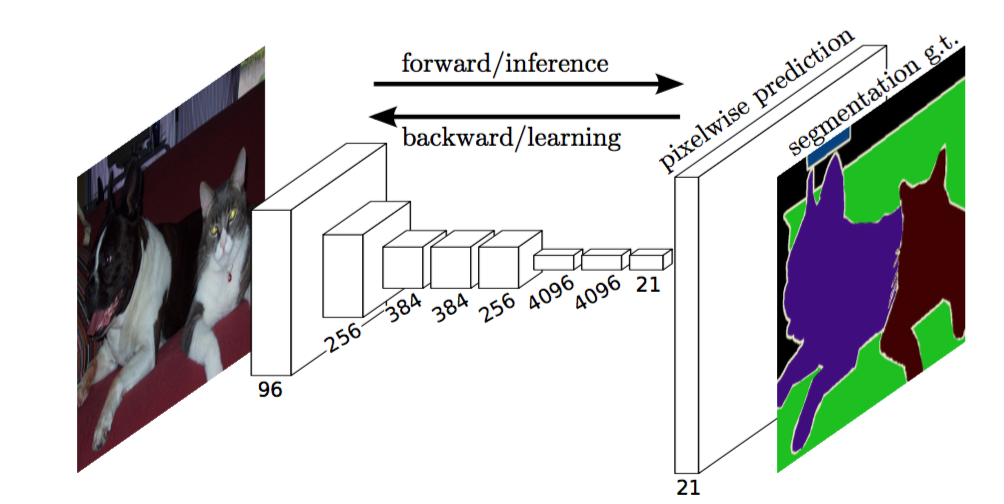

GitHub - divamgupta/image-segmentation-keras: Implementation of Segnet, FCN, UNe...
source link: https://github.com/divamgupta/image-segmentation-keras
Go to the source link to view the article. You can view the picture content, updated content and better typesetting reading experience. If the link is broken, please click the button below to view the snapshot at that time.

README.md
Image Segmentation Keras : Implementation of Segnet, FCN, UNet, PSPNet and other models in Keras.
Implementation of various Deep Image Segmentation models in keras.
Link to the full blog post with tutorial : https://divamgupta.com/image-segmentation/2019/06/06/deep-learning-semantic-segmentation-keras.html
Our Other Repositories
- Attention based Language Translation in Keras
- Ladder Network in Keras model achives 98% test accuracy on MNIST with just 100 labeled examples
Contributors
Divam Gupta : https://divamgupta.com
Models
Following models are supported:
model_name Base Model Segmentation Model fcn_8 Vanilla CNN FCN8 fcn_32 Vanilla CNN FCN8 fcn_8_vgg VGG 16 FCN8 fcn_32_vgg VGG 16 FCN32 fcn_8_resnet50 Resnet-50 FCN32 fcn_32_resnet50 Resnet-50 FCN32 fcn_8_mobilenet MobileNet FCN32 fcn_32_mobilenet MobileNet FCN32 pspnet Vanilla CNN PSPNet vgg_pspnet VGG 16 PSPNet resnet50_pspnet Resnet-50 PSPNet unet_mini Vanilla Mini CNN U-Net unet Vanilla CNN U-Net vgg_unet VGG 16 U-Net resnet50_unet Resnet-50 U-Net mobilenet_unet MobileNet U-Net segnet Vanilla CNN Segnet vgg_segnet VGG 16 Segnet resnet50_segnet Resnet-50 Segnet mobilenet_segnet MobileNet SegnetExample results for the pre-trained models provided :
Input Image Output Segmentation Image



Getting Started
Prerequisites
- Keras 2.0
- opencv for python
- Theano / Tensorflow / CNTK
sudo apt-get install python-opencv sudo pip install --upgrade keras
Installing
Install the module
pip install keras-segmentation
or
git clone https://github.com/divamgupta/image-segmentation-keras
cd image-segmentation-keras
python setup.py installpip install will be available soon!
Pre-trained models:
import keras_segmentation model = keras_segmentation.pretrained.pspnet_50_ADE_20K() # load the pretrained model trained on ADE20k dataset model = keras_segmentation.pretrained.pspnet_101_cityscapes() # load the pretrained model trained on Cityscapes dataset model = keras_segmentation.pretrained.pspnet_101_voc12() # load the pretrained model trained on Pascal VOC 2012 dataset # load any of the 3 pretrained models out = model.predict_segmentation( inp="input_image.jpg", out_fname="out.png" )
Preparing the data for training
You need to make two folders
- Images Folder - For all the training images
- Annotations Folder - For the corresponding ground truth segmentation images
The filenames of the annotation images should be same as the filenames of the RGB images.
The size of the annotation image for the corresponding RGB image should be same.
For each pixel in the RGB image, the class label of that pixel in the annotation image would be the value of the blue pixel.
Example code to generate annotation images :
import cv2 import numpy as np ann_img = np.zeros((30,30,3)).astype('uint8') ann_img[ 3 , 4 ] = 1 # this would set the label of pixel 3,4 as 1 cv2.imwrite( "ann_1.png" ,ann_img )
Only use bmp or png format for the annotation images.
Download the sample prepared dataset
Download and extract the following:
https://drive.google.com/file/d/0B0d9ZiqAgFkiOHR1NTJhWVJMNEU/view?usp=sharing
You will get a folder named dataset1/
Using the python module
You can import keras_segmentation in your python script and use the API
import keras_segmentation model = keras_segmentation.models.unet.vgg_unet(n_classes=51 , input_height=416, input_width=608 ) model.train( train_images = "dataset1/images_prepped_train/", train_annotations = "dataset1/annotations_prepped_train/", checkpoints_path = "/tmp/vgg_unet_1" , epochs=5 ) out = model.predict_segmentation( inp="dataset1/images_prepped_test/0016E5_07965.png", out_fname="/tmp/out.png" ) import matplotlib.pyplot as plt plt.imshow(out)
Usage via command line
You can also use the tool just using command line
Visualizing the prepared data
You can also visualize your prepared annotations for verification of the prepared data.
python -m keras_segmentation verify_dataset \ --images_path="dataset1/images_prepped_train/" \ --segs_path="dataset1/annotations_prepped_train/" \ --n_classes=50
python -m keras_segmentation visualize_dataset \ --images_path="dataset1/images_prepped_train/" \ --segs_path="dataset1/annotations_prepped_train/" \ --n_classes=50
Training the Model
To train the model run the following command:
python -m keras_segmentation train \ --checkpoints_path="path_to_checkpoints" \ --train_images="dataset1/images_prepped_train/" \ --train_annotations="dataset1/annotations_prepped_train/" \ --val_images="dataset1/images_prepped_test/" \ --val_annotations="dataset1/annotations_prepped_test/" \ --n_classes=50 \ --input_height=320 \ --input_width=640 \ --model_name="vgg_unet"
Choose model_name from the table above
Getting the predictions
To get the predictions of a trained model
python -m keras_segmentation predict \ --checkpoints_path="path_to_checkpoints" \ --input_path="dataset1/images_prepped_test/" \ --output_path="path_to_predictions"
Fine-tuning from existing segmentation model
The following example shows how to fine-tune a model with 10 classes .
import keras_segmentation from keras_segmentation.models.model_utils import transfer_weights pretrained_model = keras_segmentation.pretrained.pspnet_50_ADE_20K() new_model = keras_segmentation.models.pspnet.pspnet_50( n_classes=51 ) transfer_weights( pretrained_model , new_model ) # transfer weights from pre-trained model to your model new_model.train( train_images = "dataset1/images_prepped_train/", train_annotations = "dataset1/annotations_prepped_train/", checkpoints_path = "/tmp/vgg_unet_1" , epochs=5 )
Projects using keras-segmentation
Here are a few projects which are using our library :
- https://github.com/SteliosTsop/QF-image-segmentation-keras paper
- https://github.com/willembressers/bouquet_quality
- https://github.com/jqueguiner/image-segmentation
- https://github.com/theerawatramchuen/Keras_Segmentation
- https://github.com/neheller/labels18
- https://github.com/shsh-a/segmentation-over-web
- https://github.com/chenwe73/deep_active_learning_segmentation
- https://github.com/vigneshrajap/vision-based-navigation-agri-fields
- https://github.com/ronalddas/Pneumonia-Detection
- https://github.com/Aiwiscal/ECG_UNet
- https://github.com/TianzhongSong/Unet-for-Person-Segmentation
- https://github.com/Guyanqi/GMDNN
- https://github.com/kozemzak/prostate-lesion-segmentation
- https://github.com/lixiaoyu12138/fcn-date
- https://github.com/sagarbhokre/LyftChallenge
- https://github.com/TianzhongSong/Person-Segmentation-Keras
- https://github.com/divyanshpuri02/COCO_2018-Stuff-Segmentation-Challenge
- https://github.com/XiangbingJi/Stanford-cs230-final-project
- https://github.com/lsh1994/keras-segmentation
- https://github.com/SpirinEgor/mobile_semantic_segmentation
- https://github.com/LeadingIndiaAI/COCO-DATASET-STUFF-SEGMENTATION-CHALLENGE
- https://github.com/lidongyue12138/Image-Segmentation-by-Keras
- https://github.com/laoj2/segnet_crfasrnn
- https://github.com/rancheng/AirSimProjects
- https://github.com/RadiumScriptTang/cartoon_segmentation
- https://github.com/dquail/NerveSegmentation
- https://github.com/Bhomik/SemanticHumanMatting
If you use our code in a publicly available project, please add the link here ( by posting an issue or creating a PR )
Recommend
About Joyk
Aggregate valuable and interesting links.
Joyk means Joy of geeK
